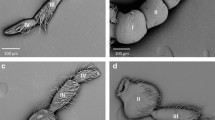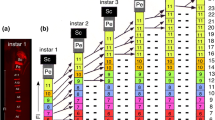Summary
-
1.
1. The cuticular apparatus of the basiconic sensilla in Necrophorus is built up by four cells: the enveloping cell No. 1 secretes the dendritic sheath, the trichogen cell produces the part of the hair with pores, the tormogen cell the hairbase without pores, and the enveloping cell No. 4 produces the base and the ringwall of the sensillum.
-
2.
2. The development of the hair starts with the growth of the sheathed dendrite. This growth is homologue to the increase in length of the dendrite during moulting in hemimetabole insects.
-
3.
3. The trichogen cell surrounds the dendrite only up to 2 μ distal of the epithelial surface and then grows beside the dendrite to the full length of the future hair. After having secreted the cuticulin layer the free ends of sheath and dendrite degenerate.
-
4.
4. The development of the pore tubules system begins with the secretion of the cuticulin layer. When the hairwall has reached 30% of its thickness the pore tubules are fully developed. The outer liquor space is formed by withdrawal of the trichogen cell from the newly built hair. The dendrite grows into the hair inside the retreating trichogen cell. Few hours after emerging from the pupa the dendrite begins to split into about 50 branches: between the microtubules of the dendrite many vesicles arise which then fuse into continuous interspaces.
Zusammenfassung
-
1.
1. Der cuticuläre Apparat der basiconischen Sensillen von Necrophorus wird von 4 Zellen gebildet. Hüllzelle 1 bildet die Dendritenscheide, die trichogene Zelle den von Poren durchsetzten Teil des Haares, die tormogene Zelle die porenfreie Haarbasis und Hüllzelle 4 Sockel und Ringwall des Sensillums.
-
2.
2. Die Entwicklung der Haaranlage wird durch einen Wachstumsschub des von einer Scheide umgebenen Dendriten eingeleitet. Dieser Wachstumsschub ist der Längenzunahme des Dendriten während der Häutung bei Hemimetabolen homolog.
-
3.
3. Die trichogene Zelle umschließt den Dendriten nur bis zu 2 μ oberhalb der Epitheloberfläche und wächst dann neben ihm zur vollen Länge des künftigen Haares aus. Mit Abscheidung der Cuticulinschicht degeneriert das freie Ende von Dendrit und Scheide.
-
4.
4. Die Anlage des Poren-Tubulus-Systems beginnt mit der Abscheidung der Cuticulinschicht. Bei Erreichen von ca. 30% der Haarwandstärke sind auch die Porentubuli ausgebildet. Der äußere Liquorraum entsteht durch Zurückweichen der trichogenen Zelle aus dem neu gebildeten Haar. Der Dendrit wächst innerhalb der sich zurückziehenden trichogenen Zelle in das Haar ein. Wenige Stunden nach dem Schlüpfen beginnt sich der Dendrit durch Vesikulierung und anschließende Vesikelfusion in ca. 50 Äste aufzuspalten.
Similar content being viewed by others
Literatur
Altner, H., Ernst. K.-D., Karuhize, G.: Untersuchungen am Postantennalorgan der Collembolen (Apterygota). I. Die Feinstruktur der postantennalen Sinnesborste von Sminthurus fuscus (L.). Z. Zellforsch. 111, 263–285 (1970).
Altner, H., Thies, G.: Reizleitende Strukturen und Ablauf der Häutung an Sensillen einer euedaphischen Collembolenart. Z. Zellforsch. 129, 196–216 (1972).
Barth, F. G.: Der sensorische Apparat der Spaltsinnesorgane (Cupiennius salei Keys. Araneae). Z. Zellforsch. 112, 212–246 (1971).
Behnke, O., Forer, A.: Evidence for four classes of microtubules in individual cells. J. Cell Sci. 2, 169–192 (1967).
Blaney, W. M., Chapman, R. F.: The fine structure of the terminal sensilla on the maxillary palps of Schistocerca gregaria (Forskål) (Orthoptera, Acrididae). Z. Zellforsch. 99, 74–97 (1969b).
Blaney, W. M., Chapman, R. F., Cook, A. G.: The structure of the terminal sensilla on the maxillary palps of Locusta migratoria (L.) and changes associated with moulting. Z. Zellforsch. 121, 48–68 (1971).
Boeckh, J.: Elektrophysiologische Untersuchungen an einzelnen Geruchsrezeptoren auf den Antennen des Totengräbers (Necrophorus, Coleoptera). Z. vergl. Physiol. 46, 212–248 (1962).
Borg, T. K., Norris, D. M.: Ultrastructure of sensory receptors on the antennae of Scolytus multistriatus (Marsh.). Z. Zellforsch. 113, 13–28 (1971).
Chu, I-Wu, Axtell, R. C.: Fine structure of the dorsal organ of the house fly larva Musca domestica L. Z. Zellforsch. 117, 17–34 (1971).
Dallai, R.: First data on the ultrastructure of the postantennal organ of Collembola. Rev. Ecol. Biol. Sol. 8, 11–29 (1971).
Ernst, K.-D.: Die Feinstruktur von Riechsensillen auf der Antenne des Aaskäfers Necrophorus (Coleoptera). Z. Zellforsch. 94, 72–102 (1969).
Filshie, B. K., Waterhouse, D. F.: The structure and development of a surface pattern on the cuticle of the green vegetable bug Nezara viridula. Tissue and Cell 1, (2) 367–385 (1969).
Foelix, R. F., Axtell, R. C.: Fine structure of tarsal sensilla in the tick Amblyoma americanum (L.). Z. Zellforsch. 114, 22–37 (1971).
Hansen, K., Heumann, H.-G.: Die Feinstruktur der tarsalen Schmeckhaare der Fliege Phormia terraenovae Rob.-Desv. Z. Zellforsch. 117, 419–442 (1971).
Kaißling, K. E.: Insect olfaction. In: Handbook of sensory physiology, vol. IV: Chemical senses (ed. L. M. Beidler), p. 351–431. Berlin-Heidelberg-New York: Springer 1971.
Karuhize, G. R.: The structure of the postantennal organ in Onychiurus sp. (Insecta: Collembola) and its connection to the central nervous system. Z. Zellforsch. 118, 263–282 (1971).
Lawrence, P. A.: Development and determination of hairs and bristles in the Milkweed bug Oncopeltus fasciatus (Lygaeidae, Hemiptera). J. Cell Sci. 1, 475–498 (1966).
Lewis, C. T., Marshall, A. T.: The ultrastructure of the sensory plaque organs of the antennae of the chinese lantern fly Pyrops candelaria L. (Homoptera, Fulgoridae). Tissue and Cell 2, (3) 375–385 (1970).
Locke, M.: The permeability of insect cuticle to water and lipids. Science 147, 295–298 (1965).
Locke, M.: The structure and formation of the cuticulin layer in the epicuticle of an insect. Calpopodes ethlius (Lepidoptera, Hesperiidae). J. Morph. 118, 461–494 (1966).
Moran, D. T., Varela, F. G.: Microtubules and sensory transduction. Proc. nat. Acad. Sci. (Wash.) 68, (4) 757–760 (1971).
Moulins, M.: Etude ultrastructurale d'une formation de soutien épidermo-conjonctive inédite chez les Insectes. Z. Zellforsch. 91, 112–134 (1968).
Myers, J.: The structure of the antennae of the Florida queen butterfly Danaus gilippus berenice (Cramer). J. Morph. 125, 315–328 (1968).
Nicklaus, R., Lundquist, P. G., Wersäll, J.: Elektronenmikroskopie am sensorischen Apparat der Fadenhaare auf den Cerci der Schabe Periplaneta americana. Z. vergl. Physiol. 56, 412–415 (1967).
Overton, J.: Microtubules and microfibrils in morphogenesis of the scale cells of Ephestia kühniella. J. Cell Biol. 29, 293–305 (1966).
Overton, J.: The fine structure of developing bristles in wild type and mutant Drosophila melanogaster. J. Morph. 122, 367–380 (1967).
Perry, M. M.: Further studies on the development of the eye of Drosophila melanogaster. II. The interommatidial bristles. J. Morph. 124, 249–262 (1968).
Richter, S.: Die Feinstruktur des für die Mechanorezeption wichtigen Bereiches der Stellungshaare auf dem Prosternum von Calliphora erythrocephala Mg. (Diptera). Z. Morph. Ökol. Tiere 54, 202–218 (1964).
Schmidt, K.: Die campaniformen Sensillen im Pedicellus der Florfliege (Chrysopa, Planipennia). Z. Zellforsch. 96, 478–489 (1969a).
Schmidt, K.: Der Feinbau der stiftführenden Sinnesorgane im Pedicellus der Florfliege Chrysopa Leach (Chrysopidae, Planipennia). Z. Zellforsch. 99, 357–388 (1969b).
Schmidt, K., Gnatzy, W.: Die Feinstruktur der Sinneshaare auf den Cerci von Gryllus bimaculatus Deg. (Saltatoria, Gryllidae). II. Die Häutung der Faden- und Keulenhaare. Z. Zellforsch. 122, 210–226 (1971).
Scott, D. A., Zacharuk, R. Y.: Fine structure of the antennal sensory appendix in the larva of Ctenicera destructor (Brown) (Elateridae: Coleoptera). Canad. J. Zool. 49, (2) 199–210 (1971a).
Slifer, E. H.: The structure of arthropod chemoreceptors. Ann. Rev. Entomol. 15, 121–142 (1970).
Slifer, E. H., Prestage, J. J., Beams, H. W.: The fine structure of the long basiconic sensory pegs of the grasshopper (Orthoptera, Acrididae) with special reference to those on the antenna. J. Morph. 101, 359–397 (1957).
Slifer, E. H., Prestage, J. J., Beams, H. W.: The chemoreceptors and other sense organs on the antennal flagellum of the grasshopper (Orthoptera, Acrididae). J. Morph. 105, 145–191 (1959).
Slifer, E. H., Sekhon, S. S.: Fine structure of the sense organs on the antennal flagellum of the honey bee Apis mellifica Linnaeus. J. Morph. 109, 351–381 (1961).
Slifer, E. H., Sekhon, S. S.: Sense organs on the antennal flagellum of the small milkweed bug Lygaeus kalmii Stal (Hemiptera, Lygaeidae). J. Morph. 112, 165–193 (1963).
Slifer, E. H., Sekhon, S. S.: Fine structure of the sense organs on the antennal flagellum of a flesh fly Sarcophaga argyrostoma R.-D. (Diptera, Sarcophagidae). J. Morph. 114, 185–207 (1964a).
Slifer, E. H., Sekhon, S. S.: The dendrites of the thin-walled olfactory pegs of the grasshopper (Orthoptera, Acrididae). J. Morph. 114, 393–410 (1964b).
Slifer, E. H., Sekhon, S. S.: Fine structure of the thin-walled sensory pegs on the antennae of a beetle, Popilius disjunctus (Coleoptera, Passalidae). Ann. entomol. Soc. Amer. 57, 541–548 (1964c).
Steinbrecht, R. A., Ernst, K.-D.: Continuous penetration of delicate tissue specimen with embedding resin. Sci. Tools 14, 24 (1967).
Steinbrecht, R. A., Müller, B.: On the stimulus conducting structures in insect olfactory receptors. Z. Zellforsch. 117, 570–575 (1971).
Thurm, U.: Mechanoreceptors in the cuticle of the honey bee: Fine structure and stimulus mechanism. Science 145, 1063–1065 (1964).
Thurm, U.: Untersuchungen zur funktionellen Organisation sensorischer Zellverbände. Verh. dtsch. Zool. Ges. Köln 64, 79–88 (1970).
Thurm, U.: Im Druck (1972).
Walcott, Ch., Salpeter, M. M.: The effect of molting upon the vibration receptor of the spider (Achaearanae tepidariorum). J. Morph. 119, (3) 383–392 (1966).
Wensler, R. J., Filshie, B. K.: Gustatory sense organs in the food canal of aphids. J. Morph. 129, 473–492 (1969).
Zacharuk, R. Y.: Fine structure of peripheral terminations in the porous sensillar cone of larvae of Ctenicera destructor (Brown) (Coleoptera, Elateridae), and probable fixation artifacts. Canad. J. Zool. 49, 789–799 (1971).
Author information
Authors and Affiliations
Additional information
Herrn Prof. Dr. H. Altner danke ich sehr herzlich für anregende Diskussionen.
Rights and permissions
About this article
Cite this article
Ernst, KD. Die Ontogenie der basiconischen Riechsensillen auf der Antenne von Necrophorus (Coleoptera). Z.Zellforsch 129, 217–236 (1972). https://doi.org/10.1007/BF00306937
Received:
Issue Date:
DOI: https://doi.org/10.1007/BF00306937




